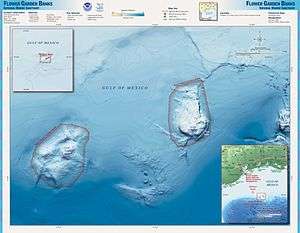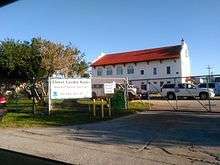Flower Garden Banks National Marine Sanctuary
| Flower Garden Banks National Marine Sanctuary | |
| Protected Area | |
| Country | United States |
|---|---|
| Region | Gulf of Mexico |
| Coordinates | 27°55′12″N 93°42′36″W / 27.92000°N 93.71000°WCoordinates: 27°55′12″N 93°42′36″W / 27.92000°N 93.71000°W |


- "Flower Gardens" redirects here: there is also an article on actual flower gardens.
The Flower Garden Banks (often simply the "Flower Gardens") is a U.S. National Marine Sanctuary in the northwestern Gulf of Mexico, located roughly 105 miles (170 km) south of Sabine Pass, an area of Port Arthur, Texas.
The formation of offshore salt domes in the warm waters of the Gulf provided a colonization site for coral, which arrived and began reef-building roughly ten to fifteen thousand years ago.
Two reefs, East Flower Garden Bank and West Flower Garden Bank, were part of the National Marine Sanctuary when it was created in 1992. In 1996, the smaller nearby Stetson Bank was added to the sanctuary.
Typical for coral reefs, the Flower Garden Banks contain a large number of aquatic species. Almost three hundred species of fish, twenty-one species of coral, several species of crustaceans, four dominant species of sponges, and a wide variety of sharks, skates, and rays. The loggerhead sea turtle is resident. Several resident whale sharks turn in frequent appearances; manta rays are also commonly sighted.
History
Although fishermen are believed to have discovered and named the Flower Garden Banks, the first recorded discovery did not occur until 1936. The Flower Garden and Stetson Banks were included in a hydrographic survey of the Gulf of Mexico, conducted by the U.S. Coast & Geodetic Survey (now the National Ocean Service, of which the National Marine Sanctuary Program is a part). The survey provided valuable information about the geology and topography of the banks. Reviewers of this and other surveys conducted in the 1950s concluded that the banks probably originated from plugs of salt pushing the overlaying sediments up to form underwater mountains.
Led by Dr. Thomas Pulley, then Director Emeritus of the Houston Museum of Natural Science, eager explorers in the early 1960s set out to determine the truth behind the rumors of coral reefs in the northern Gulf of Mexico. In addition to professional researchers, the explorers included volunteers from all walks of life. Some thought the area would be too cold, or too turbid, to support any extensive coral reef development. The scuba diving explorations, however, revealed that the Flower Garden Banks did support healthy, pristine coral reef systems.[1]
In the late 1960s, Robert Alderdice and James Covington established the Flower Gardens Ocean Research center (FGORC), heralding a period of intense multi-agency, interdisciplinary research, which continues to this day. Results of this on-going research prompted government agencies to begin discussing the need to protect the banks from increasing human activities, including oil and gas extraction, anchoring on the reefs and harvesting fish, corals and other invertebrates. With passage of the Marine Research and Sanctuaries Act in 1972, researchers began discussing the Flower Garden Banks as a candidate for designation as a National Marine Sanctuary. After extensive monitoring and data collection from 2004 to 2008, the U.S. Dept. of the Interior, Bureau of Ocean Energy Management, Regulation and Enforcement, concluded that problems that affect coral reefs throughout the region, including land-based sources of pollution, overfishing, and coral disease, have not yet had a measurable adverse effect on the Flower Garden Banks.[2]
By then, recreational divers were also entranced with the Flower Garden Banks. The Houston Underwater Club led the charge to have the banks officially designated by submitting a formal letter of nomination in 1979. Due to a number of issues, it was 11 years before President George H. W. Bush ultimately signed the document designating the Flower Garden Banks as the 10th National Marine Sanctuary on January 17, 1992. Stetson Bank was brought into the system in 1996.
As of 2009, NOAA had six divers stationed in Galveston and relied heavily on recreational divers for their scientific and conservation efforts.[3][4] With the addition of the R/V Manta in 2008, the divers log over 1,000 working dives per year.[3]
References
- ↑ Gittings, SR; Deslarzes, KJP; Holland, BS; Boland, GS. "Ecological monitoring on the flower garden banks: Study design and field methods". In: Jaap, WC (ed). Advances in Underwater Science…90. Proceedings of the American Academy of Underwater Sciences Tenth annual scientific diving symposium. Retrieved 2012-01-08.
- ↑ Long-term Monitoring at the East and West Flower Garden Banks, 2004-2008. New Orleans, LA: U.S. Dept. of the Interior, Bureau of Ocean Energy Management, Regulation and Enforcement, Gulf of Mexico OCS Region, 2010.
- 1 2 Buch, KL; Hickerson, E. "Flower Garden Banks National Marine Sanctuary and Texas A&M University at Galveston: Building a Research and Learning Partnership". In: Pollock NW, ed. Diving for Science 2009. Proceedings of the American Academy of Underwater Sciences 28th Symposium. Dauphin Island, AL: AAUS; 2009. Retrieved 2013-03-06.
- ↑ Clark, Randall D., ed. (August 2014). Fish and Benthic Communities of the Flower Garden Banks National Marine Sanctuary: Science to Support Sanctuary Management. Silver Spring, MD: U.S. Department of Commerce, National Oceanic and Atmospheric Administration, NOAA National Centers for Coastal Ocean Science. Retrieved 9 December 2015.
External links
| Wikimedia Commons has media related to Flower Garden Banks National Marine Sanctuary. |